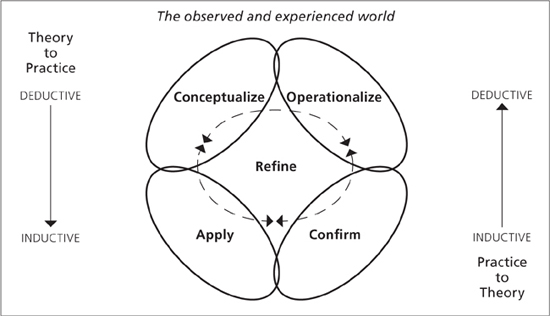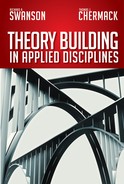12
Whatcha Gonna Do?
WE ASSUME YOU HAVE READ Chapters 1 through 11 and have now landed here at Chapter 12—our closing effort. Our minds rang with the regular refrain offered by our mutual Italian-American friend: “Whatcha gonna do?” For sure, “What are we going to do?” was exactly what we thought as we approached this concluding chapter.
• Provide an emotional appeal? No!
• Summarize the book? No!
• Look to the future? No!
• Give some solid advice for your next steps? Yes!
Our goal for this last chapter is to offer some practical advice for moving ahead with your theory-building endeavor.
THE SETUP
The General Method of Theory Building in Applied Disciplines Developing (Figure 12.1) has been detailed for the purpose of advancing both theory and practice. This method for assessing and developing sound theory in applied disciplines is meant to fill voids. Both scholars and practitioners have input into this successful methodology. Fusing information from both perspectives can yield a complete and accurate understanding of the realm being investigated.
FIGURE 12.1 General Method of Theory Building In Applied Disciplines

As we have already noted, applied disciplines must meet the standards of both scholarship and practice. The purpose of this book has been to present a complete and detailed method for developing sound theory in applied disciplines. In response to our contention that most theory development methods are incomplete, inappropriate, or totally overwhelming, we have presented down-to-earth thinking, strategies, steps, and tools for advancing theories in applied disciplines.
EVERYBODY IS A THEORIST!
We have discussed the fact that most theory in applied disciplines literature is limited to the Conceptualize phase and that theories-in-use most often do not go beyond personal theories. For sure, there is something to be learned from all these inputs, but do not be fooled as to their completeness.
In our experience, all applied disciplines have smart, articulate academics in their ranks. Sometimes these people write articles and books about their theories of their discipline. Most often they restrict themselves to the Conceptualize phase, ignore the other four phases, and add a related fable or example of practice to appear complete.
Also in our experience, all applied disciplines have smart, articulate practitioners in their ranks. Sometimes these people write articles and books about their world in action. Management consultants, automobile mechanics, medical doctors, and football coaches are some examples.
A recent practitioner book about medical doctors and how they think is an excellent example (Groopman, 2007). We are struck by the fact that this well-written, 300-page book covering how doctors go about their work diagnosing patients pretty much leaves the medical practice “theory bucket” empty by reporting interesting medical stories with no effort at building a theory of patient diagnosis. Since almost all of us have had firsthand experience being diagnosed as a patient, the potential readership is broad.
In comparison, the conceptually similar diagnosis work conducted by an automobile mechanic is more vague to us because after a few questions, we leave the shop while our car is being diagnosed and end up with little or no conceptualizing, let alone any theory of diagnosis.
Since so many people are exposed to the extensive media rhetoric about coaches of athletic teams, winning coaches are enticed into writing books about their theories of leadership and management that end up being personal theories with little generalizability.
Although all these examples leave many of the theory buckets almost empty, the popular press continues to publish boatloads of articles and books that claim to have the answers.
WHO IS BEST EQUIPPED TO BUILD THEORY?
Edward O. Wilson (1998), a renowned scholar, argued that “complexity is what interests scientists in the end, not simplicity. Reductionism is the way to understand it. The love of complexity without reductionism makes art; the love of complexity with reductionism makes science” (p. 54). He went on to note “that new ideas are commonplace and are almost always wrong. Most flashes of insight lead nowhere; statistically, they have a half-life of hours or maybe days” (p. 55).
Some would argue that theory-building research is the crème de la crème of the inquiry world. While it might be the most interesting, it probably requires the greatest commitment and tenacity. Thus, with its imposing challenges, theory building will likely entice a limited slice of scholars in any applied discipline. Even so, it is hard to say who they will be. Historically, the people most interested in serious theory building have come from academe. So often, ideas originate with practitioners and are picked up by academics who then claim credit. Theories emerge from practice just as often, if not more, than from academe. We therefore encourage those of you with working theories-in-use to take the plunge and build the robustness around your expertise. This may require reaching out to a partner with research expertise, but these relationships can make all the difference and play to the strengths of both domains.
In any case, from our experience, some characteristics of successful theory scholars include the following:
• Focused: have an intense interest in a particular realm
• Humble: realize that they don’t know everything
• Curious: are driven to know how something works
• Agile: have a mind that can look from various angles and are able to change their thinking
• Toolbox: use a rich and varied selection of inquiry methods
• Respectful: express genuine openness to input from practitioners and scholars
• Patient: accept the reality of extended time required to fulfill the theory quest
NEXT STEPS FOR YOU TO CONSIDER
Here we go in expanding on the thought of “Whatcha gonna do?” as to how to respond to the theory-building method for applied disciplines. We have three possible next steps for those who think they may be interested in engaging in theory building:
• audit existing theory,
• test an existing theory, or
• build a new theory.
Audit Existing Theory
Auditing an existing theory is the easiest of our three suggestions. Even so, this is important work and can be extremely enlightening. We suggest that you choose an applied theory realm you are interested in. Then gather up the relevant literature, use the theory assessment tool we presented in Chapter 11 to record your findings, and complete a short narrative to explain your process and conclusions.
What you find within the five phases of theory building that backs up such popular concepts as leadership, hierarchy of needs, and organizational performance might just surprise you.
Test an Existing Theory
Either through confirmation or application, any existing theory is strengthened by additional testing. This may not seem to be the flashy option, but it is important and very doable. A number of factors could ignite such a study. Replicating the theory in practice to confirm the reliability and generalizability of the theory is one. Taking the theory to a new setting to test generalizability is another. Noticing a void in the theory and adding/testing that element is a third factor.
Build a New Theory
This suggestion to build a new theory takes on the full challenge. A practical assessment as to what it takes needs to be made before moving ahead. Experienced scholars will find a natural evolution from their smaller frame or segment research efforts. This can be an easy call in wanting to dig deeper within a realm, to add substantively to the theory, and to be prepared for the theory-practice challenge.
Less experienced theory builders will most likely pursue midlevel theories that could possibly frame their focus of scholarship and practice. They should probably avoid pursuing macro theories and theory frameworks for the applied discipline itself.
DESIRED RESPONSE TO THIS BOOK
This book directly addresses the problems of the lack of clarity as to what theory is and its full dimensions. We have attempted to provide a useful method and examples that illustrate solutions to these problems. We declared earlier that Theory Building in Applied Disciplines has no rival theory development methods book. We hope you both agree and have the personal motivation to begin adding sound theory to an important realm of your interest. If we have succeeded, we would like to hear from you. If we have not succeeded, we would like to hear from you.
